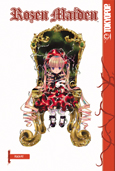Rozen Maiden: Volume 1: Inside the mind of a boy who loves dolls...
By Leroy Douresseaux
May 6, 2006 - 11:26
Tokyopop
Writer(s): Peach Pit
Penciller(s): Peach Pit
Cover Artist(s): Peach Pit
ISBN: 1-59816-312-4

There was a traumatic incident in Jun Sakurada’s life that caused him to close off the outside world. His parents travel the world collecting antiques, so he’s under the supervision of his older sister, Nori. However, he refuses to even interact with her, and she is (was) his closest friend. Like his parents, he collects things, but he does it on the Internet buying spiritual items that are obviously rip-offs. Still, Jun’s not a total rube. He only holds onto items long enough to send them back in time to get a refund.
But one day, he gets an order form from “the Spirit hollier,” which asks Jun to choose between a wind-up toy and a non-wind-up toy, and then put the order form in his desk drawer when he’s made that decision. The next day a mysterious case arrives, and it contains a doll named Shiku. With the turn of a magical key, Shiku comes to life and informs Jun that he is now her manservant. Jun doesn’t know what to make of the walking and talking bossy doll that says it is one of the “Rozen Maidens. Shiku even has a rival, a menacing witch girl named Suigintou who shows up in a whirlwind of attempted destruction. However, for all the drama Shiku brings into Jun’s life, in the end, this commotion just might be for the best – giving Jun the motivation to think about both who and what he is.
ROZEN MAIDEN is a fantasy series that TOKYOPOP has aimed at teen readers, but truthfully the manga collective Peach Pit has created a series, and executed its narrative and concept in such a manner that Rozen Maiden is clearly meant for elementary school readers. It’s not that Rozen Maiden is simple-minded or dumb, but it has a lot of wish fulfillment that might appeal to juvenile and ‘tween readers, perhaps more so than teen readers. There’s lots of magic, and the violence is only occasionally edgy.
The art is all over the place. The super-deformed is too deformed, but there are panels that are drawn in a beautiful, airy, and whimsical fashion. However, there are panels that are drawn in such a sketchy fashion that it’s obvious to even the youngest readers that the artist hasn’t drawn in the panel what the writer says in happening. That makes it hard to follow the story visually, which is a real problem because comics – even manga – are a visual medium.
One thing Rozen Maiden really has going for it is the narrative’s emphasis on psychology and emotion over plot. The story is all about the interior person. Issues of identity, confidence, fear, and self-loathing drive all the plot elements. When an adversary attacks, it’s not just because there’s a point in the story where some action is needed. Conflict is a time to examine and test mental strength rather than physical prowess.
While Rozen Maiden certainly isn’t a splendid example of manga, it is something that American comics must do more of if they wish to expand their readership (and not just their base of superhero comics readers). That something is comics about self-discovery. Not at all “touch-feely,” Rozen Maiden quietly demands that its central character take a hard look at himself and his faults and weaknesses. That’s OK reading for the audience for which TOKYOPOP intended Rozen Maiden and those even younger.
Related Articles:
Rozen Maiden: Volume 1: Inside the mind of a boy who loves dolls...
